We all know that hiking can be physically, mentally, and even emotionally tiring, but is hiking good exercise?
Yes, hiking is a great form of exercise! It can improve cardiovascular health, build strength and endurance, and even boost mental health. Plus, it’s a low-impact activity that can be enjoyed by people of all ages and fitness levels.
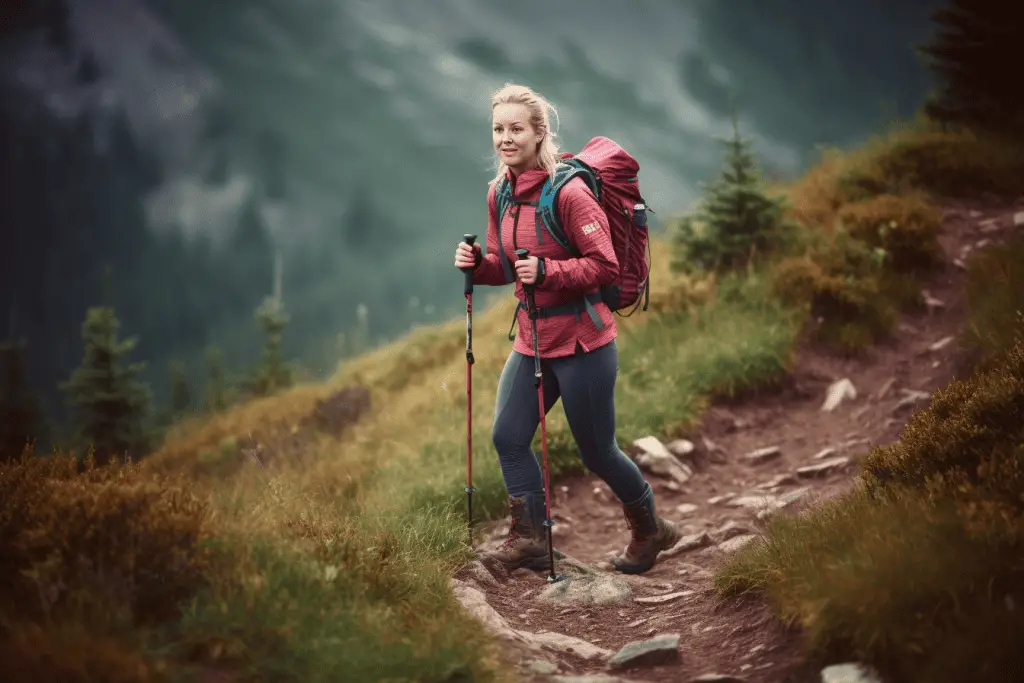
The Physical Benefits of Hiking: From Strength to Cardiovascular Health
Well, let’s dive right in, shall we? Hiking isn’t just about trudging up hills and admiring scenic views, it’s a powerhouse for physical health, too. I’m talking about strength and cardiovascular fitness. Sounds interesting, right?
So, what’s so special about hiking, you ask? Unlike the monotony of the gym, hiking has you climbing steep hills, navigating uneven terrain, and maybe even scrambling over rocks. Each of these activities gives your muscles, particularly those in your lower body, a fantastic workout. Your quads, glutes, hamstrings, and even your core and upper body get a piece of the action. It’s a complete, full-body strength training session, sans the dumbbells.
Now, onto cardiovascular health. As you’re probably aware, any form of exercise that gets your heart pumping is a winner for cardiovascular fitness. But with hiking, the changing intensity as you move over different terrains makes for an excellent natural interval training session. That’s your heart rate alternating between high and low intensity, which not only increases your fitness levels, but also helps your body burn calories more efficiently, even at rest.
And the cherry on top? Hiking is a weight-bearing exercise, which means it strengthens your bones and reduces the risk of osteoporosis.
Is Hiking Good Exercise for Improving Flexibility?
Time to shine a light on some of the unsung heroes of hiking benefits – flexibility and balance. These two are often overlooked but trust me, they’re game-changers in your fitness journey and overall health.
Ever noticed how hiking trails are full of surprises? You’re not just strolling down a flat, predictable path. Oh no, you’re stepping over roots, hopping from rock to rock, and sometimes maneuvering through narrow or tricky stretches. All these natural obstacles make for an unexpected flexibility workout. They require you to stretch, bend, and twist in all sorts of ways you might not in a more structured exercise setting. It’s like nature’s version of a yoga class!
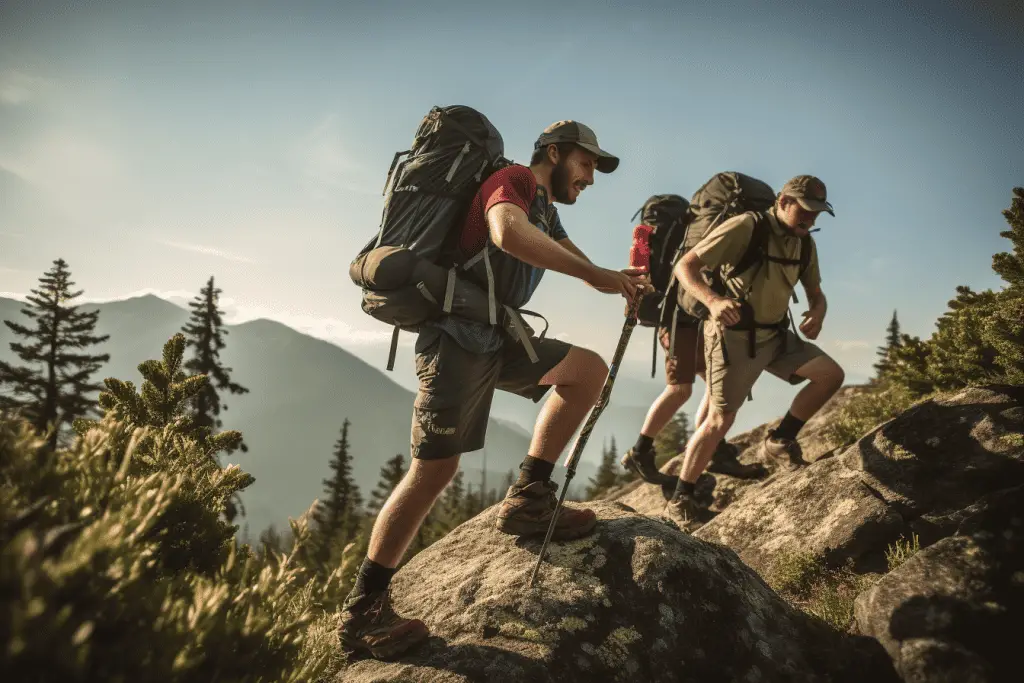
And balance, you ask? Well, those same uneven surfaces and unexpected obstacles also challenge your balance big time. Maintaining stability on a hiking trail helps improve your proprioception, which is a fancy term for your body’s ability to sense its position and movement in space. Improved balance doesn’t just benefit your hike; it’s also crucial for preventing falls and injuries in everyday life, especially as we age.
Furthermore, these varied terrains can also help strengthen your stabilizing muscles, particularly in your core and lower body. These muscles aren’t always engaged during traditional gym workouts, but they’re essential for good posture and overall physical stability.
Is Hiking Good Exercise for Weight Loss?
Who knew that the path to weight management could lead through a forest, up a mountain, or around a lake? Let’s delve deeper into how hiking can be your new best buddy in maintaining a healthy weight.
First things first, hiking burns calories – and plenty of them. The exact number depends on various factors like your weight, the intensity of the hike, and the terrain. But as a rule of thumb, expect to burn somewhere between 400 to 550 calories per hour. Not too shabby, right? And since it’s such an engaging activity, you’ll likely find yourself hiking for longer periods than you might stay on a treadmill or elliptical, leading to an even higher caloric burn.
But there’s more to this story. Remember our earlier chat about hiking providing a natural interval workout? Those bursts of increased intensity – when you’re powering up a hill, for example – are excellent for boosting your metabolism. This means that your body continues to burn calories at a higher rate even after you’ve kicked off your hiking boots for the day.
What’s more, hiking is a form of resistance exercise, especially when you’re trekking uphill or at a brisk pace. This helps to build muscle, and more muscle equals more calorie-burning power. See where we’re going with this?
So, if you’re looking for a fun, effective way to manage your weight that doesn’t involve monotonous gym workouts, hiking could well be your answer. And the beautiful views? They’re just the icing on the cake.
Hiking and Endurance: Building Stamina over Time
Time to put on your endurance hat! Let’s journey into how hiking is not just a one-time workout, but rather a fantastic tool to boost your stamina over time. Intrigued? You should be!
Ever huffed and puffed during the first few hikes only to find yourself breezing through similar trails a couple of months later? That, my friend, is the magic of hiking building your endurance. You see, with each step you take and each hill you conquer, you’re gradually conditioning your body to work more efficiently.
By frequently tackling varying terrains and elevations, your heart and lungs learn to distribute oxygen to your muscles more effectively. The result? Over time, you’ll notice that you can hike longer distances, or tackle more challenging trails, without getting winded. It’s like a superhero training regime, but instead of fighting villains, you’re conquering trails!
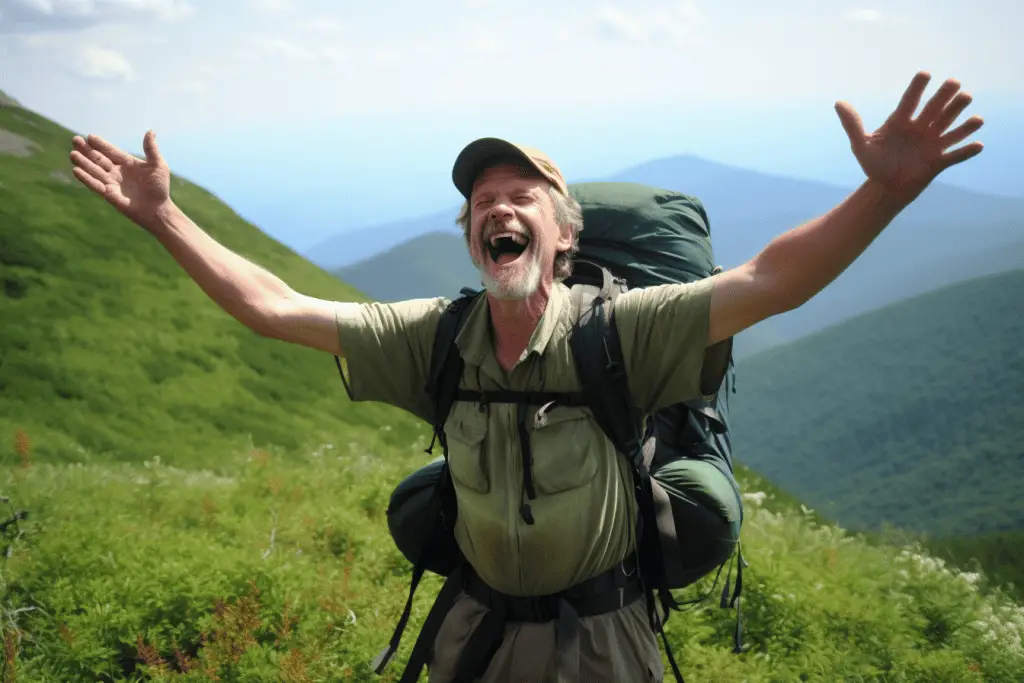
And the best part? This increased stamina doesn’t just apply to hiking. It spills over into your everyday life, making other physical activities easier. So, that set of stairs at work that used to make you feel like you climbed Mount Everest? It’ll become a piece of cake!
To put it simply, hiking is not just about the immediate workout. It’s a long-term relationship with your body where both of you work together to build stamina and endurance. And as with all good relationships, it only gets better with time!
Is Hiking Good Exercise for Your Mind?
It’s no secret that spending time in nature has a calming effect on the mind. The gentle rustle of leaves, the chirping of birds, the breathtaking vistas – they all contribute to a sense of peace and tranquility. But did you know there’s actual science behind this? Research on the health benefits of hiking shows that immersing ourselves in nature can reduce stress hormones, lower blood pressure, and even improve mood. It’s like a natural prescription for happiness!
Moreover, hiking requires you to be present in the moment – to navigate the trail, to appreciate your surroundings, to adapt to the terrain. This mindfulness, or active focus on the present, is a powerful tool in combating anxiety and depressive thoughts. It’s a bit like meditation but with dirt trails and occasional squirrel sightings.
Let’s not forget the sense of achievement that comes from completing a challenging hike. Conquering a steep hill or navigating a tricky path can boost your self-esteem and confidence, which are key components of mental well-being.
Hiking and Social Connections: Getting Fit with Friends
Alright, folks, time to gather ’round and chat about how hiking isn’t just about getting fit and connecting with nature, it’s also a great way to strengthen social bonds. Yes, you heard it right – hiking can be a group affair!
Ever noticed how conversations seem to flow more naturally while you’re strolling down a trail? That’s no coincidence. Walking side by side, sharing the same experience, and tackling the same challenges can foster a unique sense of camaraderie. Deep discussions, lighthearted banter, shared silence – they all find a place on the hiking trail.
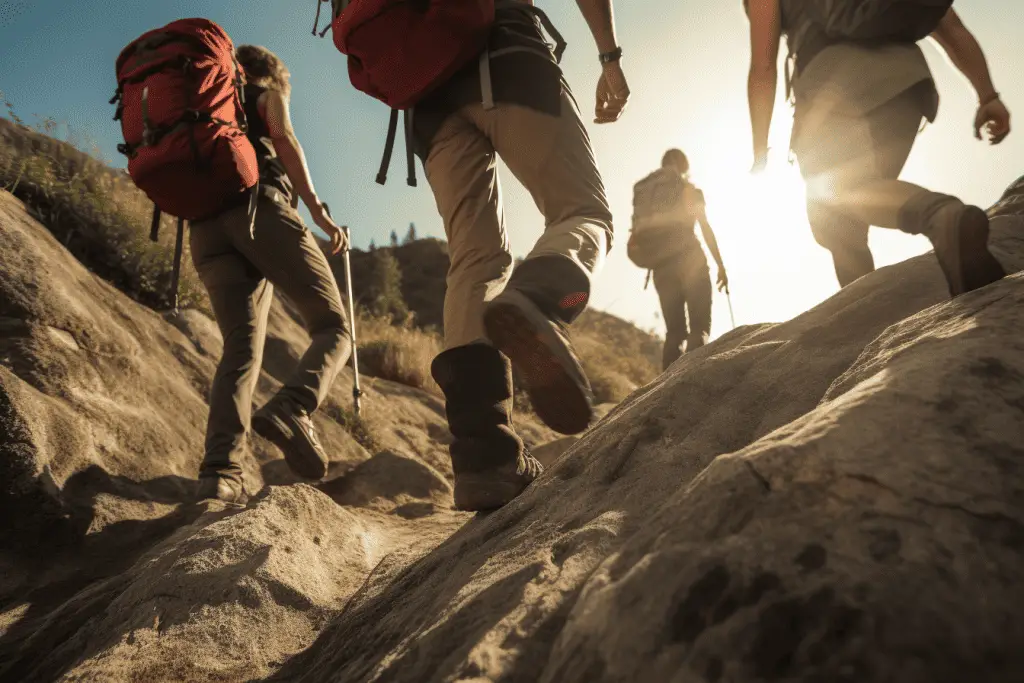
Group hikes can be a fantastic way to connect with friends, and family, or even make new acquaintances. And let’s face it, having a buddy to share the breathtaking views, or maybe just to grumble with about that surprisingly steep hill, can make the experience more rewarding.
What’s more, hiking with others can be a source of motivation and accountability. Knowing that you’re meeting a friend for a sunrise hike can make it easier to roll out of bed and lace up your hiking boots. Plus, a little friendly competition never hurt anyone, right?
So, whether it’s a family outing, a catch-up with friends, or a team-building exercise, hiking offers an opportunity to build stronger social connections while reaping the physical and mental health benefits. Quite a winning combo, don’t you think?
The Versatility of Hiking: Adapting for All Fitness Levels
Let’s bust a myth today, shall we? Hiking isn’t just for the ultra-fit or the adventure junkies. One of the beautiful things about hiking is its versatility. No matter where you stand on the fitness spectrum, there’s a trail out there just waiting for you.
If you’re new to the exercise game or just starting your fitness journey, no worries at all. There are plenty of flat, well-marked trails that you can take at your own pace. You’ll still get a decent workout and enjoy all the perks we’ve been talking about, but without straining yourself.
On the other hand, if you’re in the prime of your fitness life and looking for a challenge, hiking has got you covered there, too. Try a steep, rough trail or one at a higher altitude, and I promise, your muscles will feel the burn!
The best part is that as your fitness level improves, you can gradually move to more challenging trails. This keeps your workouts exciting and ensures that you’re continuously improving and testing your endurance, strength, and balance.
The Adventure of Hiking: Making Exercise Fun and Exciting
Alright, let’s take a moment to talk about one of my favorite things about hiking – the sheer adventure of it! Because let’s face it, the same old gym routine can get boring after a while, right? But with hiking, it’s a different story altogether.
First off, no two hikes are ever the same. One day, you might be exploring a dense forest trail, the next you could be conquering a mountain peak, and the day after, maybe you’re strolling along a peaceful coastal path. Each hike brings with it a new set of sights, sounds, and experiences that keep the activity fresh and exciting.
And then there’s the element of surprise. You never know what you might encounter on a hike. Maybe you’ll spot a deer darting through the trees, stumble upon a hidden waterfall, or catch a breathtaking sunset just as you reach the top of a hill. These unexpected moments of wonder add a sense of adventure that’s hard to find on a treadmill.
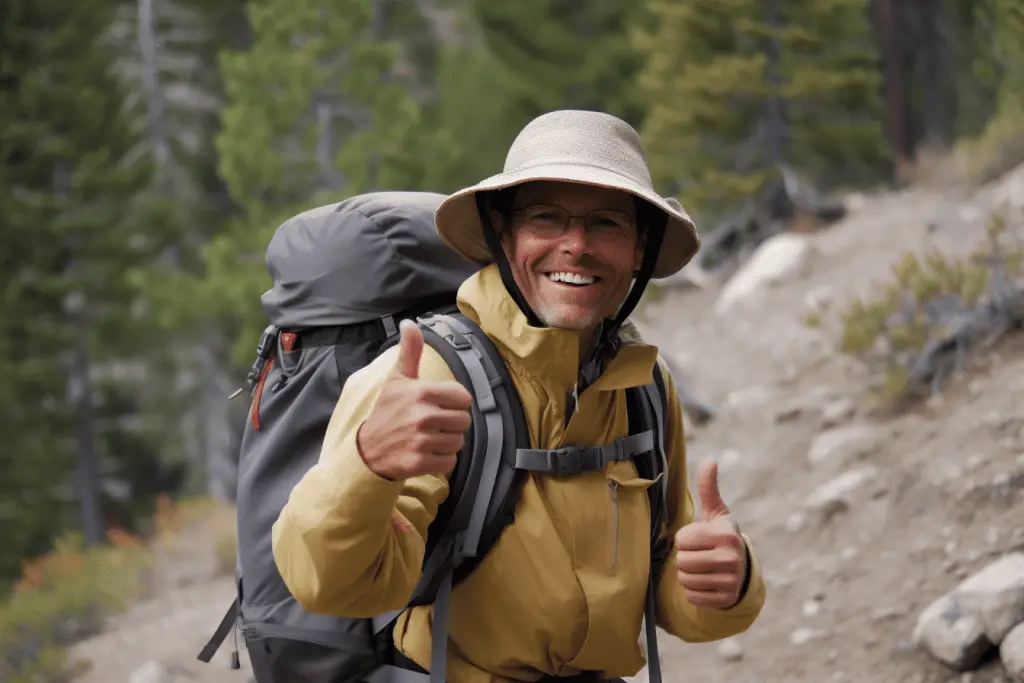
Not to mention, hiking allows you to challenge yourself in new ways. Whether it’s navigating a tricky trail, reaching a new altitude, or improving your hiking speed, there’s always a new goal to strive for, a new achievement to unlock.
In a nutshell, hiking makes exercise feel less like a chore and more like an adventure. It’s a way to get fit while also exploring the world around you, experiencing the beauty of nature, and satisfying your inner adventurer. So why not swap the gym for the great outdoors once in a while and inject a dose of excitement into your fitness routine? Trust me, you won’t regret it!
Hiking vs. Gym Workouts: A Comparative Analysis
Alright, time for a face-off: hiking vs. gym workouts. Both are excellent ways to get fit, but they offer different experiences and benefits.
Let’s start with the gym, the classic go-to for fitness. Gym workouts are structured, predictable, and let’s not forget – climate-controlled. They offer a wide range of equipment allowing for targeted, specific muscle training. Plus, you’ve got trainers on hand to guide you and classes to add variety to your routine. Sounds pretty good, right?
But here’s the thing – gyms can also feel monotonous. Doing the same exercises in the same environment can be mentally draining for some people. Not to mention, it can get crowded, and if we’re being honest, not everyone is a fan of the ‘gym atmosphere’.
Enter hiking. With hiking, the world is your gym. You’re out in the fresh air, surrounded by nature. No two trails are the same, so it’s always a new experience. It’s a full-body workout that engages different muscles at different times, depending on the trail’s terrain. Plus, it offers a mental health boost that’s hard to get in a gym.
Of course, hiking has its own challenges. It’s weather-dependent, and it can be hard to track your progress without the precise metrics you get in the gym. Plus, without the right gear or preparation, it can lead to injuries.
So, which one’s the winner? Well, it’s not about beating the other; it’s about what suits you best. Some people might prefer the structure and convenience of the gym, while others might enjoy the adventure and variety of hiking. Or, better yet, you could incorporate both into your routine to get the best of both worlds. Sounds like a win-win to me!
Hiking Tips for Maximum Fitness Benefits
If you’re looking to boost your fitness level while enjoying the great outdoors, hiking is an unbeatable choice. But like any form of exercise, it’s important to approach it with a bit of know-how to maximize its potential benefits and ensure a safe and enjoyable experience.
Here’s a list of some essential tips to help you get the most out of your hiking adventures, whether you’re a seasoned hiker or just lacing up your boots for the first time.
- Choose the Right Trail for Your Fitness Level: Don’t jump straight into a challenging trail if you’re a beginner. Start with easy, flat routes and gradually move to more difficult ones as your fitness improves.
- Warm-Up Before You Start: Just like any other workout, a good warm-up is crucial before hiking. A simple routine involving stretching and light cardio can help prepare your body and reduce the risk of injuries.
- Use the Right Gear: Invest in a good pair of hiking boots for comfort and support. Also, consider using hiking poles. They’re not just for stability but can also provide a great upper body workout.
- Stay Hydrated and Fuelled: Carry plenty of water and nutritious snacks. Staying hydrated and maintaining your energy levels is essential for endurance and overall performance.
- Pace Yourself: Hiking is not a race. Start slow, especially on longer or steeper trails, to conserve energy and maintain a steady pace.
- Use Your Whole Body: Engage your core for stability, use your arms for balance or to propel yourself forward, and make sure you’re using your glutes on those uphill stretches!
- Mix It Up: Try different trails to keep your workouts exciting and challenging. Each trail will engage different muscle groups and offer varied cardiovascular intensity.
- Mind Your Posture: Keep your back straight, shoulders relaxed, and look ahead. Good posture not only prevents strain and injury, but it also makes your hike more efficient.
- Cool Down After Your Hike: Just as with warming up, a good cool-down session with some stretching can help prevent muscle stiffness and soreness.
- Rest and Recover: Don’t forget to give your body time to rest and recover after hiking, especially after more strenuous hikes. Remember, fitness improvements happen during recovery!
- Have Fun!: The more you enjoy hiking, the more likely you are to do it regularly, reaping all those amazing fitness benefits. So, explore new trails, hike with friends, and always take a moment to appreciate the scenery!
There you have it, a comprehensive guide to making the most of your hiking workouts. Remember, the key to any fitness regimen is consistency, and with hiking, it’s no different. By following these tips, you’ll not only improve your physical strength, endurance, and flexibility, but you’ll also get to explore the natural world in a way that no gym can ever offer. So, lace up, gear up, and hit the trails. Your adventure awaits!
